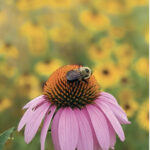I am surged—“which way do I go?!?”—as the available garden chores and delights rush in along with the early warm spring days.
While it might not seem warm enough to start growing vegetables, this is a perfect time for what are called “cool season crops.” Where tomatoes, peppers and squash like basking in the hot summer sun, the early vegetable garden loves cool days and light, frosty nights.
Let’s start with some basic tips for success.
Firstly, it’s all about the soil. I add a bunch of leaf compost and organic nutrients into my garden beds in autumn. This “cooks” all winter, providing an amazing soil to work with every spring. I haven’t roto-tilled in years. Many gardeners overdo the roto-tilling, getting too enthusiastic about running it back and forth, actually damaging the soil structure. The extra rotations grind the soil particles finer, creating clay and chopping up the helpful worms. I add more organic nutrients each spring as they are “slower releasing” than chemical fertilizers (which have to be applied more frequently). Using a garden fork loosens up and turns the soil—a nice raking then levels it back off.
A soil test at least every few years is a good idea to know what the soil nutrient levels are. Penn State offers this service. The test kits are available at both your courthouse and at garden centers. This information can clue optimum fertility for growing vegetables.
Seed-starting seems to be a scary proposition for many gardeners. Luckily, the crops we’re discussing here are super easy to start, and they are directly sown into the prepared garden. Success tastes so good!
Beginning around the second week of March (I watch for the first dandelions to start blooming), we start with potatoes, onions, spinach and lettuce. Peas scoot in about two weeks later.
Potatoes for planting are called “seed potatoes.” These are chunks of potatoes with “eyes” on them, the sprouts that grow the tops. Place one seed per foot about 3 inches deep and cover. Every few weeks, cover the growing plant with compost and straw, keeping only a few inches of the tops exposed. “New” potatoes can be harvested a few months into the growing season—or allow full-sized growth, harvesting in autumn.
Onion sets are partially grown beginner onions. This means someone else started the tiny seeds then harvested the small onion bulbs. These sets can be planted right into the garden, and they are on their way again. These types, called “green onions,” are usually harvested while still small and chopped into early salads or grilled. I use them in rows as markers between my other crops instead of planting them all together. Plant 3 inches deep to bottom of the bulb and 3 inches apart. If you want big slicing sweet onions, these are a different type. They are planted later, around the time you get tomatoes in.
Spinach and lettuce are started now, too. They love the cool weather and grow quickly. Spinach seeds are planted ½-inch deep. Harvesting foliage by cutting leaves off low to the base encourages them to re-sprout more leaves. Lettuce seeds need light to germinate, so they are simply scattered on top. Then use a hand to gently press them into nice contact with the soil. Both can be planted in rows or broadcast into an area. I plant them in the spots where my tomatoes will be planted later. As the summer heat comes on, spinach and lettuces “bolt,” which means they send up a flower stalk, indicating they are finished. My tomatoes then fill the now-available space.
Near the end of March, I plant pea seeds about 2 inches apart at the base of a trellis for climbing. You can choose snow peas and sugar peas, which have edible pods, or shelling peas. They love the cooler weather, and, as the summer heat comes on, this trellis becomes what my cucumbers climb on. The trick here is to keep picking to keep getting peas. If pods are left too long on the vines, the plant is signaled to quit producing. Young peas can be plucked and popped right into the mouth for a super tasty treat.
Beets, carrots, Swiss chard, cilantro, dill, parsnips and turnips all appreciate this early start. Go ahead, start the seeds and the dreams of harvest!
Erica Shaffer is the nursery manager at Highland Gardens, 423 S. 18th St., Camp Hill. www.highlandgardens.org.






